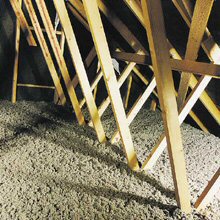Cellulose Insulation
Cellulose insulation is commonly made from recycled newspaper treated with fire retardant. The main ingredient to cellulose insulation is Borate. Cellulose is a great product for insulating. It is blown into areas using an insulation hopper and since it is ground up it fills all voids when applied properly. It has good insulation value, R 3.7 per inch, but is better than fiberglass because of its ability to be installed properly.
We prefer to install stabilized cellulose insulation in attics. When blowing the insulation in it goes through a wetting system which moistens the insulation. The insulation is treated with starch so it hardens a little after it dries. The main reasons for installing insulation like this is to minimize dust (both for the installer and the homeowner), it gets into all of the voids better, the installer can see what they are installing (with normal blown in it is far too dusty to see), and there is minimal settling of the material. We are one of the only contractors in the area that installs stabilized cellulose insulation.
Cellulose dense pack
Cellulose dense pack is blown into walls, existing covered or open wall, and cavities. It has an R-Value of 3.2 per inch and can be installed properly.
In an open wall cavity the cellulose is blown in damp and sticks to the wall, and itself, until the wall cavity is full. After, the excess is scrubbed off using a scrubber tool. It is allowed to dry then the sheetrock can be installed. All voids are filled using this method and density and moisture checks let us know that you are applying it properly.
In a closed wall cavity holes are drilled in the top and bottom of your wall cavities and the cellulose is injected in. The entire cavity fills up with dense pack cellulose which gives you great air sealing along with great insulation. We always double check our work using a high grade infra red camera. If we find voids with our IR camera we always fill them immediately. Some contractors choose to install this insulation from the outside by drilling holes. We do not practice this method because it requires drilling through the waterproofing of your wall, which is behind the siding or stucco. It can lead to leaks that can be very costly.
Fiberglass batt insulation
Fiberglass batt insulation is a great insulator. It has a good R-Value per inch, 3.0, and can be found without contaminants such as formaldehyde. The main drawback of fiberglass batts is the difficulty with installation. They must be installed without compressions or voids and this is very difficult in most circumstances. We take great pride in installing fiberglass batts to the highest standards when we do use them.
Fiberglass loose-fill
Fiberglass loose fill insulation is blown in with a hopper like cellulose insulation. It has an R-Value of 2.8. It is blown in so it isn’t too difficult to get it into all of the voids which make it perform up to its rating.
Fiberglass dense pack
Fiberglass dense pack is primarily installed in existing covered wall cavities. – In a closed wall cavity holes are drilled in the top and bottom of your wall cavities and the fiberglass is injected in. The entire cavity fills up with dense pack fiberglass which gives you great air sealing along with great insulation. We always double check our work using a high grade infra red camera. If we find voids with our IR camera we always fill them immediately.
Denim insulation
Denim insulation is a batt insulation that is normally installed in cavities like fiberglass batts. It is made from recycled jeans and other denim products and treated with fire retardant. It is a good insulator but is difficult to install properly
Foam insulation
Polyurethane foam insulation is a great insulator. It can have an R-Value of 6.0 per inch, which is the best in our industry. It is expanding foam that fills voids and air seals at the same time it insulates. The drawback of foam insulation is that it is expensive, is made from petroleum and off gasses (lets off it’s fumes) for days. The off gassing is usually bad enough that the house will not be livable for a few days.
Closed cell foam insulation is an air and vapor barrier. This means it can be used on an unvented roofing shell as a vapor barrier. This comes in handy when we are sealing attics and with cathedral ceilings that are not vented (these are generally the only two places that we use it.)
Open cell foam insulation is an air barrier but not a vapor barrier. It is still a great insulator and less expensive than it’s closed cell brother.
Rigid Foam insulation
Rigid foam insulation is a good insulator. When installed properly it can have an R-Value of 5 per inch. It is difficult to install properly but has great uses for us in the home performance industry. It comes in 4’ x 8’ sheets and is cut to fit in where we need it. It is used in places from knee walls to cathedral ceilings.
Bib installed insulation
Bib installed insulation is used when cavities are open during construction. Cavities, such as walls, are covered with a plastic or mesh material and stapled to the wood. Once the thin sheeting is installed we blow in cellulose or fiberglass insulation into the wall cavity. This is a good way to ensure that all voids are filled and the sheetrock is in full contact with the insulation.

